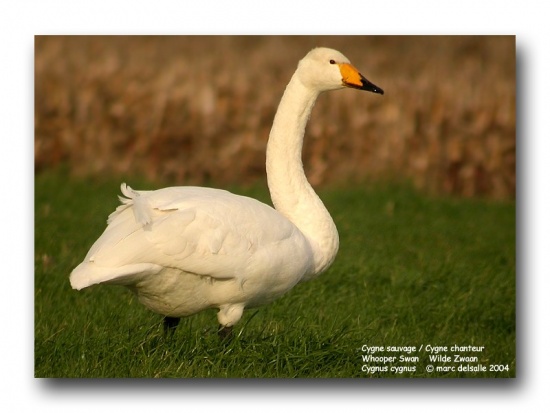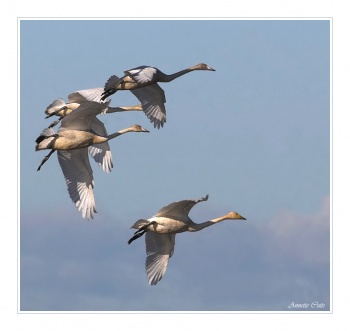(Attempt to disguise copied text. Flight photos, video link. Reference updated) |
|||
| Line 38: | Line 38: | ||
[[Category:Birds]][[Category:Cygnus]][[Category:Bird Songs]] [[Category:Videos]] | [[Category:Birds]][[Category:Cygnus]][[Category:Bird Songs]] [[Category:Videos]] | ||
| + | |||
| + | http://ptaki-doliny-baryczy.manifo.com/ | ||
Revision as of 15:39, 23 January 2013
- Cygnus cygnus
Identification
140-160cm
- White body
- Long thin neck
- Black legs
- Black bill with large triangular yellow patch
Similar Species
Mute Swan has a red bill and in Bewick's Swan the yellow on the beak is 'rounded'.
Distribution
Breeds in Iceland, in small numbers in coastal north Norway, in north-central and sparsely in south-central Sweden, north and east Finland and across Arctic Russia. In recent decades has begun to breed in Poland and an occasional breeder in Estonia, Latvia, Belarus and Scotland. The very small numbers breeding in Scotland (and occasionally Northern Ireland) may involve injured birds that have been prevented from migrating.
Icelandic birds are only partially migratory with some birds wintering, particularly in the west. The remainder winter in Scotland and Ireland. The small numbers that winter in south and east England probably originate from the Continental breeding populations which winter from coastal north Norway to the Baltic and east to north-east France, in parts of Central Europe and around the eastern Mediterranean, Black and Caspian Seas. Leave breeding grounds mid September-October and begin return movement in March-April, arriving in May.
Vagrancy
Wanders widely in severe winters and can turn up almost anywhere in Europe. Vagrant north to Svalbard and south to Israel and North Africa.
Taxonomy
This is a monotypic species[1].
Habitat
Breeds on lakes and pools in forest or on tundra, sometimes in river deltas, estuaries and sheltered sea inlets. In winter found in coastal areas or lakes and large rivers, often grazing in fields.
Behaviour
Nesting
Both sexes build the nest. The clutch of 4-7 eggs is incubated by the female for about 36 days. The cygnets can fly at an age of 120 to 150 days.
Diet
The diet includes aquatic plants, grass, and grain.
Vocalisation
<flashmp3>Cygnus cygnus (song).mp3</flashmp3>
Listen in an external program
References
- Clements, JF. 2010. The Clements Checklist of Birds of the World. 6th ed., with updates to December 2010. Ithaca: Cornell Univ. Press. ISBN 978-0801445019. Spreadsheet available at http://www.birds.cornell.edu/clementschecklist/Clements%206.5.xls/view
- RSPB
Recommended Citation
- BirdForum Opus contributors. (2024) Whooper Swan. In: BirdForum, the forum for wild birds and birding. Retrieved 4 May 2024 from https://www.birdforum.net/opus/Whooper_Swan
External Links






